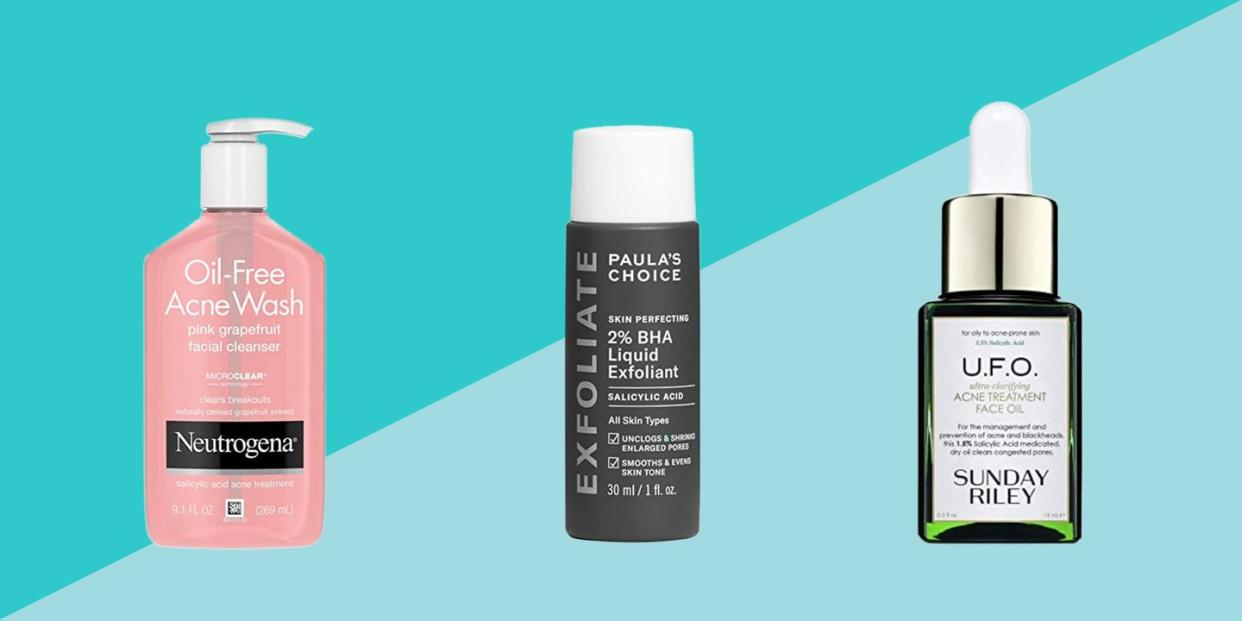20 Best Acne Treatments for Clear, Glowing Skin, According to Dermatologists

"Hearst Magazines and Yahoo may earn commission or revenue on some items through the links below."
More than 50 million Americans experience acne, making it one of the most common skin conditions in the United States. However, since there are many causes of acne, it can be tough figuring out how to find the best acne treatment for your specific needs.
So, how do you best treat it? By understanding what causes acne. “Acne occurs when the hair follicles become blocked,” says Imran Aslam, M.D., a board-certified dermatologist specializing in medical adult dermatology and skin cancer treatments in Sterling, Virginia.
“The skin cells are regularly turning over, and when this process gets interrupted cells can accumulate and occlude the hair follicle leading to a build-up of oil and dead skin cells within the pore. This then serves as an ideal environment for bacteria to grow, resulting in the red blemishes we see,” he explains.
Acne is also prevalent among teenagers, due to the rapid change in androgens (a type of hormone) that increases during puberty in young boys and girls. This increase causes the sebaceous glands to get bigger and make more sebum, leading to breakouts. For older women, hormonal changes, either around the monthly cycle or during a menopausal shift, can also be the culprit. However, dietary imbalances and stress also cause acne flare-ups and breakouts, according to Dr. Aslam.
How to find the best treatment
To find the best treatment, you’ll have to factor in a few things, like your age, sex, the type of acne you have (mild, moderate, or severe), and more to determine your specific needs. “Since acne can present itself in complex ways, it is important to seek expert consultation early with a dermatologist to determine the type of acne you have,” says Dr. Aslam. “Depending on the severity, adult acne can be treated with topical creams, oral medications, or a combination of both.”
How we chose the products
Fortunately, there are tons of drugstore acne products you can purchase in-store or online to treat pimples, blackheads, and more. So we took the time to select 20 of the best dermatologist-approved acne treatments to help you clear up those pesky bumps fast. Ranging from face washes to acne spot treatments—our list also includes affordable and top-rated picks from customer reviews.
Ahead, learn about a few expert tips that can help treat blemishes as well as new products you can incorporate into your acne-clearing skincare routine.
Eat fewer refined carbs

“Eating chocolate or a lot of junk food doesn’t by itself seem to cause acne, but not having a balanced diet and eating too many refined carbs can cause problems,” says Albert Lefkovits, M.D., director of the Park Avenue Center for Advanced Medical and Cosmetic Dermatology in New York City.
Researchers found that “high glycemic loaded diets may exacerbate acne.” Foods high on the glycemic index (GI) tend to be higher in refined carbs, like those found in white bread. Scientists also suspect that raised insulin levels from the carbs may trigger a release of hormones that inflame follicles and increase oil production.
In another study, scientists found that people who consumed low GI foods had lower levels of IGF-1, a hormone known to trigger acne breakouts.
If you suspect your diet may be the culprit, steer clear of these high GI foods (meaning they have a score of 70 or higher) and see if you notice a difference: sugary snacks and beverages, white bread, bagels, corn flakes, instant oatmeal, white rice, potatoes, pretzels, popcorn, and certain fruits, like watermelon.
Consume less milk
While more research needs to be done to understand how dairy intake may lead to acne, a growing body of studies suggests the link is there.
Researchers found that milk consumption—particularly skim milk, which is higher in sugar than whole milk—was associated with a greater risk of acne. Beyond the higher sugar content, scientists believe that proteins and hormones found in milk products, including IGF-1, may play a role in acne flare-ups by increasing oil production and inflammation.
Surprisingly, yogurt and cheese seem to be a mystery, as they don’t seem to cause the same effect, according to a scientific analysis.
So if you regularly drink milk, consider switching to a non-dairy alternative like almond milk to see if your skin improves. “Look for something that has fewer than 10 grams of sugar per serving,” says Dr. Lefkovits.
Try antibacterial face washes and topical retinoids

For mild to moderate acne, dermatologists often suggest an acne face wash with bacteria-killing benzoyl peroxide (to minimize irritation, 3.5 percent strength should be your max if you have sensitive skin), along with a benzoyl peroxide acne spot treatment.
Stronger cases may call for prescription retinoids (such as Retin-A or Tazorac), which “are really the standard of care for most acne therapy,” says Joshua Zeichner, M.D., director of cosmetic and clinical research in dermatology at Mount Sinai Hospital in New York City. Certain drugs, such as Epiduo and Ziana, combine retinoids with antibacterials and may be more effective than separate products. Because retinoids also have anti-wrinkle properties (they help stimulate collagen production), they are especially beneficial for adult acne sufferers.
Look for salicylic acid
Among the most popular OTC acne treatments is salicylic acid, which is incorporated into gels, wipes, creams, and face washes. “Salicylic acid is a beta hydroxy acid (BHA) in the category of active ingredients called salicylates, derived from willow bark,” said Ava Shamban, M.D., a board-certified dermatologist in Santa Monica and Beverly Hills, Calif., in a previous interview for Prevention.com.
“It gets to work like a little jackhammer,” Dr. Shamban adds, breaking down dead skin cells and dissolving impurities that build up and cause breakouts. To keep the skin from becoming too dry, look for formulas that contain 2% salicylic acid which is a standard amount.
Manage your stress
“Stress doesn’t create breakouts on its own, but it can make any existing issues worse,” says Beth McLellan, M.D., director of dermatology at Jacobi Medical Center and researcher at Montefiore Einstein Center for Cancer Care in New York City.
Researchers haven’t established why stomach-churning anxiety may lead to adult acne, but they do believe stress hormones such as cortisol are what increase inflammation levels in the body and stimulate oil glands. In any case, managing stress through exercise, meditation, or whatever method helps relax your nerves may also calm your skin.
Consider blue light therapy
Blue light rays penetrate follicles to kill off acne-causing bacteria. For severe cases, photodynamic therapy adds a topical solution called Levulan to blue light therapy. Note that these treatments can cause temporary redness and may not be covered by insurance. Prices vary greatly depending on the location and severity of acne but can cost at least $50 for one blue light treatment and $100 or more per photodynamic therapy session. Most patients will need multiple treatments to see effective results, but many dermatologists offer package deals.
If you’re on a budget and have mild to moderate adult acne, at-home devices like the below could work as good alternatives but may not be as effective as in-office treatments.
Try using tea tree oil
Less irritating than its chemical cousin benzoyl peroxide, tea tree oil has a long history of fighting mild to moderate acne outbreaks. The oil, which comes from the leaves of a tree native to Australia, has antiseptic properties that help reduce acne-causing bacteria on the skin and quell inflammation in skin cells.
“We’ve seen it work against a wide range of organisms, including 27 of the 32 strains of acne-causing bacteria,” says Michael Murray, N.D., a naturopath and coauthor of The Encyclopedia of Natural Medicine. Multiple studies, including a review of research in the International Journal of Dermatology, back the plant’s power. You can find tea tree oil in a wide variety of soaps, skin washes, and topical solutions. Look for a minimum concentration of 5% of the oil to test how your skin reacts. If you find it is too irritating as an all-over treatment, you can use tea tree as a simple spot treatment for more stubborn pimples.
Cut back on salt

Some doctors suspect that sodium has consequences for the skin because the iodine frequently found in table salt and some seafood may worsen acne breakouts. In fact, one study found that patients suffering from acne consumed significantly higher amounts of salty foods compared to an acne-free control group.
Stick to low-sodium versions of packaged foods, try to keep your overall salt consumption below 2,300 mg a day (per the FDA), and stay away from these healthy foods that are secretly loaded with salt.
Ask your doctor about birth control pills
Oral contraceptives can help normalize hormonal surges and regulate monthly cycles so that oil glands don’t go into overdrive, says Dr. Zeichner. Doctors may prescribe one of four brands of birth control pills—Yaz, Beyaz, Estrostep, and Ortho Tri-Cyclen—that are FDA approved for treating acne. As always, patients taking oral contraceptives should be aware of potential birth control side effects, including blood clots or vaginal dryness.
Swap out your daily moisturizer
“Even acne-prone teenagers need to moisturize to keep their skin barrier healthy. The skin barrier can become damaged from drying acne products and medications,” says Arielle Kauvar, M.D., director of New York Laser & Skin Care and clinical professor of dermatology at New York University School of Medicine.
Stick with oil-free, noncomedogenic, fragrance-free moisturizers if you’re struggling with irritation. This ensures your moisturizer won’t further clog your pores or exacerbate existing breakouts. The following derm-approved picks below, are a good place to start.
You Might Also Like

